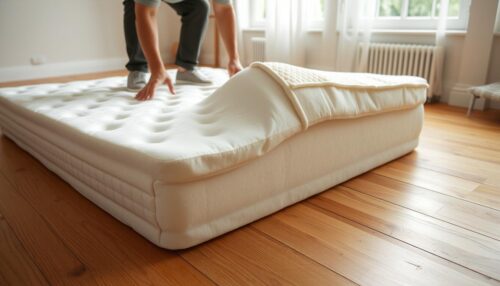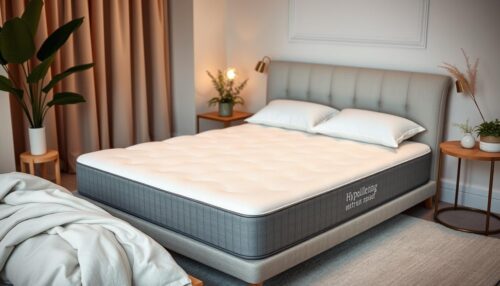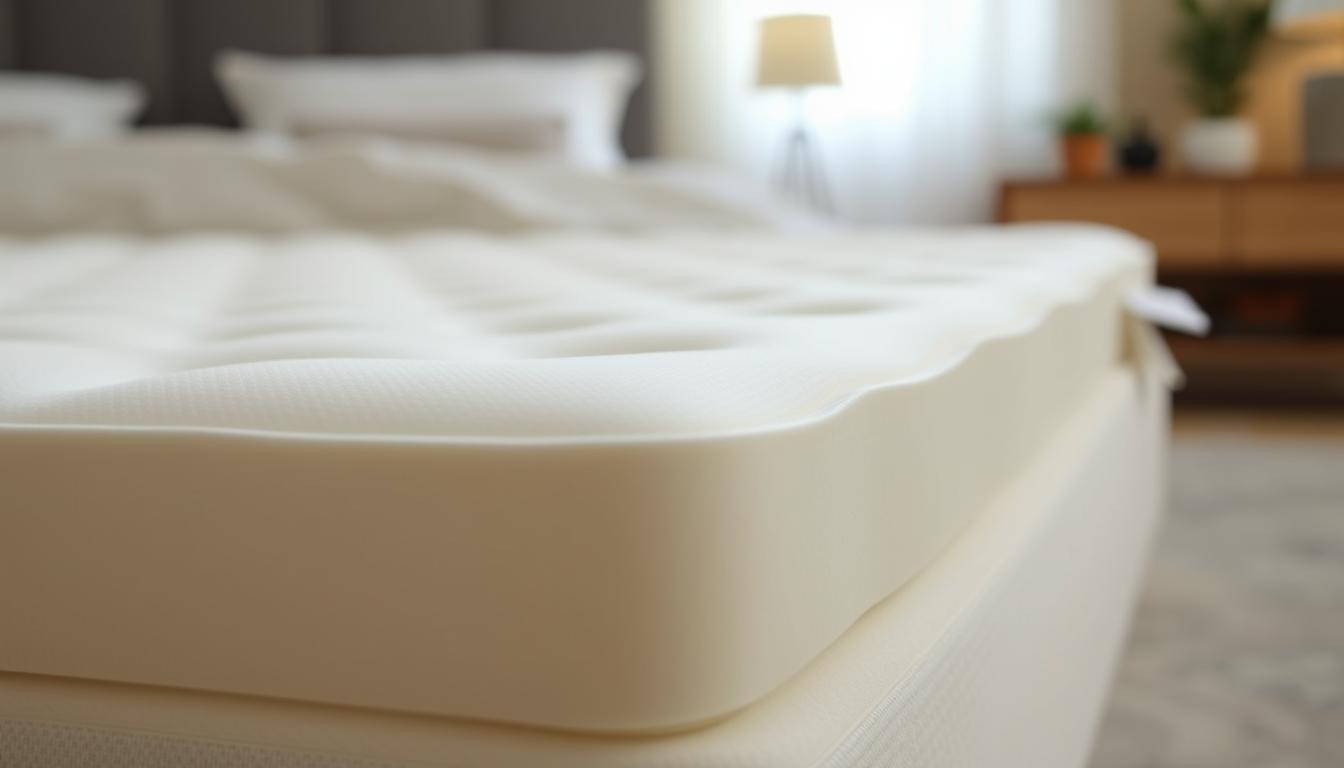Disclosure
This website is a participant in the Amazon Services LLC Associates Program, an affiliate advertising program designed to provide a means for us to earn fees by linking to Amazon.com and affiliated sites.
Memory foam mattress toppers are popular for extra comfort and support. But, they have some downsides to think about before buying. Issues like heat retention, initial odors, and movement problems might not suit everyone.
Memory foam helps with pressure and keeps motion down. Yet, it can hold heat, which is bad for those who sleep hot. These toppers are also heavy, making them hard to move and set up, a big problem for older adults or those with mobility issues.
Also, memory foam toppers can smell when you first open them. This smell might bother some people. Plus, they can be pricey and not good for those with allergies or sensitivities to chemicals.
Lastly, these toppers can sink in over time and may not last as long as other materials, like latex.
Key Takeaways
- Memory foam toppers can trap heat and be less ideal for hot sleepers.
- The heavy weight of memory foam toppers can make them difficult to move and set up.
- Memory foam toppers may emit an initial odor when first unboxed.
- Memory foam toppers can be more expensive than other bedding options.
- Memory foam toppers may not be suitable for individuals with allergies or chemical sensitivities.
1. Limited Breathability and Heat Retention
Memory foam mattress toppers have a big problem: they don’t breathe well and hold heat. Their thick, shape-hugging design blocks air, making it hard to stay cool at night. This is a big issue for people who sleep hot or live in warm places.
How Memory Foam Traps Heat
Memory foam’s special ability to hug your body also traps heat. Its thick, soft nature stops air from moving through. So, your body heat gets stuck in the foam, making it hard to sleep comfortably.
The Impact on Sleep Quality
Memory foam toppers’ heat retention can hurt your sleep. High temperatures can mess up your sleep cycle. This makes it hard to fall and stay asleep, leading to tired mornings.
Alternatives for Hot Sleepers
If you sleep hot, there are better options. Bamboo-infused memory foam or open-cell memory foam toppers let air through better. Natural materials like latex or wool also keep you cool, making them great for hot sleepers.
2. Heavy Weight and Difficulty in Handling
Memory foam mattress toppers are very heavy. They can weigh 50 to 100 pounds or more. This makes them hard to move, set up, or adjust on your bed.
This is a big problem for people with mobility issues. It’s also tough for those who like to change their bedroom layout often.
Challenges in Moving and Setting Up
It’s hard to lift and move a heavy memory foam topper. They are big and bulky. This makes it hard to get them up stairs or through narrow doors.
It’s also hard to put them on the bed. This can be a big hassle, like when you need to clean it or change your sheets.
Weighing Your Options
When thinking about a memory foam mattress topper, consider the good and the bad. Thicker toppers, 3 to 4 inches high, are heavier. But they also offer more comfort and support
You have to decide if the comfort is worth the trouble of moving and setting it up.
| Topper Thickness | Weight Range | Handling Difficulty | Comfort and Support |
|---|---|---|---|
| 2-3 inches | 30-50 lbs | Moderate | Good |
| 3-4 inches | 50-100 lbs | High | Excellent |
| 4+ inches | 75-150 lbs | Very High | Exceptional |

3. Initial Odor After Unboxing
When you open a new memory foam mattress topper, you might smell something bad. This smell is called off-gassing. It happens because of chemicals used to make the mattress. This smell can last a few days to weeks.
What Causes the Smell?
Memory foam smells more than natural materials like latex. This is because it’s made with chemicals. When it expands, these chemicals come out, making the “new mattress” smell.
How Long Will It Last?
The smell doesn’t last long. Studies show that less than 5% of Amerisleep users complain about the smell. But, some brands have more complaints. This is because of the type of foam used.
Look for mattresses with CertiPUR-US® certification. They off-gas less. Open windows and let it air out for 24 hours. This way, the smell will go away, and you can enjoy your new mattress.
4. Potential Allergens and Chemical Sensitivities
Memory foam mattress toppers might have allergens and chemical sensitivities. These can cause problems for people with sensitive skin or breathing issues.
Understanding Off-Gassing
Memory foam often has a problem called “off-gassing.” This means it releases harmful chemicals that smell bad. These chemicals can make people feel sick, like headaches or breathing problems.
Choosing Hypoallergenic Options
- If you worry about memory foam allergy risks, look at hypoallergenic mattress toppers. They are less likely to cause allergies.
- Choose toppers made from natural stuff like latex or organic cotton. They are better for you than synthetic foams.
- Stay away from toppers with bad chemicals, like flame retardants or VOCs.
- Check if the product has certifications like CertiPUR-US or GOTS. This means it’s safe and hypoallergenic.
Being careful about what’s in your mattress topper can help. It can make your sleep safer and more comfortable.

5. Body Impression and Longevity Issues
Memory foam mattress toppers can get body impressions over time. These happen where you press the most, like shoulders, hips, and lower back. This makes the surface uneven and less comfy.
These toppers last from three to five years. The quality and how you use it affect this. Cheaper ones sag faster than the expensive ones. To make it last longer, rotate it often and spread the weight evenly.
Addressing Sagging
Seeing a lot of sagging or impressions? Try rotating the topper 180 degrees. This spreads the pressure and lessens the dips. Also, make sure the weight is spread out to stop more sagging.
But, if the sag is over 1.5 inches, it’s time for a new one. A saggy topper can hurt your sleep and back, causing pain and health problems.
Knowing about memory foam durability concerns and mattress topper lifespan helps you choose wisely. Regular rotation, even weight, and replacing when needed keep your sleep comfy for years.
6. Not Ideal for All Sleeping Positions
Memory foam mattress toppers are great for some sleepers but not all. They’re perfect for side sleepers because they ease pressure. But, they might not work as well for back and stomach sleepers.
Side Sleepers vs. Back Sleepers
Memory foam molds to your body, easing pressure points. This is great for side sleepers, who get cushioning for their shoulders and hips. But, back sleepers might find these toppers too soft. This can cause their spine to curve in an unnatural way, leading to discomfort.
Finding the Right Fit
- Side sleepers should look for a topper that’s 2-4 inches thick for the right pressure relief.
- Back sleepers might prefer a firmer, thinner topper (1-2 inches) to keep their spine straight.
- Stomach sleepers need little cushioning to avoid sinking too much. A thin mattress pad might be best.
It’s key to pick a memory foam topper that fits your body and sleep style. Trying different ones and thinking about what feels right for you can help. This way, you’ll find the best mattress topper for your sleep style.
7. Price Point Compared to Other Options
Memory foam mattress toppers are pricey. They cost more than polyester blends or feathers. But, they offer great contouring and pressure relief.
Are You Getting Value for Money?
Prices for memory foam toppers vary a lot. You can find them for under $50 or over $400. For example, the Tempur-Pedic TEMPUR-Adapt Topper costs $419. But, the Linenspa Gel Swirl Memory Foam Mattress Topper is just $97.
Budget-Friendly Alternatives
Looking for something cheaper? There are affordable mattress toppers out there. The ViscoSoft Memory Foam Mattress Topper costs between $144 and $200. The Tuft & Needle Foam Mattress Topper is $161 to $189.
Choosing a memory foam topper depends on your needs and budget. Think about what you want in comfort and support. This way, you can find a good deal that meets your needs.
8. Motion Transfer and Isolation Challenges
Finding the right mattress topper is key, and motion isolation is a big deal for couples. Memory foam is great at keeping motion to a minimum. But, it can be hard to move or change positions because it molds to your body.
How Memory Foam Responds to Movement
Memory foam mattress toppers are known for their motion-isolating skills. They take time to adjust and hug your body. So, when one person moves, the other is less likely to feel it.
Options for Couples
- Memory foam is often the best choice for couples who want to reduce motion transfer. It helps you sleep better without being disturbed.
- But, some might not like the feeling of sinking into memory foam. Latex toppers are a good alternative. They offer good motion isolation and are more responsive.
- Hybrid toppers mix memory foam with coils. They give a bit of bounce and also absorb motion well.
The right mattress topper for couples depends on what they prefer. Think about motion transfer, how responsive it is, and how comfortable it feels. This way, you can find the perfect topper for a good night’s sleep.
| Mattress Type | Motion Isolation Rating |
|---|---|
| Memory Foam | Great |
| Poly Foam | Good |
| Latex | Fair-Good |
| Hybrid | Good |
| Innerspring | Poor-Fair |
| Air (Dual Chamber) | Fair |
9. Difficulty in Cleaning and Maintaining
Memory foam mattress toppers are hard to clean because they are dense and sensitive to moisture. Unlike regular mattresses, most can’t be washed in a machine. It’s important to clean and take care of them right to keep them comfy and supportive.
Special Care Instructions
To keep your memory foam topper in great shape, follow these tips:
- Use a protective cover or mattress pad to stop stains and soak up moisture.
- Quickly clean any spills or stains with a mild detergent and cool water.
- Don’t soak the topper in water or use strong chemicals, as they can harm the foam.
- Let the topper air dry completely after cleaning to stop mold and mildew.
- Turn and flip the topper often to make sure it wears evenly.
When to Replace Your Topper
Memory foam mattress toppers don’t last forever. You might need a new one when you see these signs:
- Persistent odors: If your topper smells bad even after cleaning, it’s time for a new one.
- Visible stains or discoloration: Tough stains that won’t go away mean your topper is getting old.
- Loss of support and comfort: As memory foam gets older, it can’t mold to your body as well, making sleep harder.
Knowing how to care for your memory foam mattress topper can make it last longer. A bit of extra effort can help you beat the memory foam maintenance challenges. This way, your topper will stay a key part of your sleep setup.
10. Firmness Preferences May Vary
Finding the right firmness in memory foam toppers can be tricky. What feels good in a store might not be right for your sleep. Everyone likes different firmness levels, and the wrong one can ruin your sleep.
Understanding Your Comfort Level
Think about your body weight, how you sleep, and any pain when picking a topper. The mattress world uses a scale from 1 to 10 for firmness. Soft mattresses are 3 to 6, and medium-firm ones are around 6.5. They aim to balance comfort and support.
Choosing the Right Level of Support
About 80% of people like mattresses between 5 and 7 on the firmness scale. Medium-firm (6) is the top choice. Side sleepers like a medium to medium-firm mattress (5-6). Back sleepers need a medium-firm to slightly firm (6-7). Stomach sleepers prefer a medium-firm to firm (6-8). Knowing what you need can help you find the right support for a good night’s sleep.

